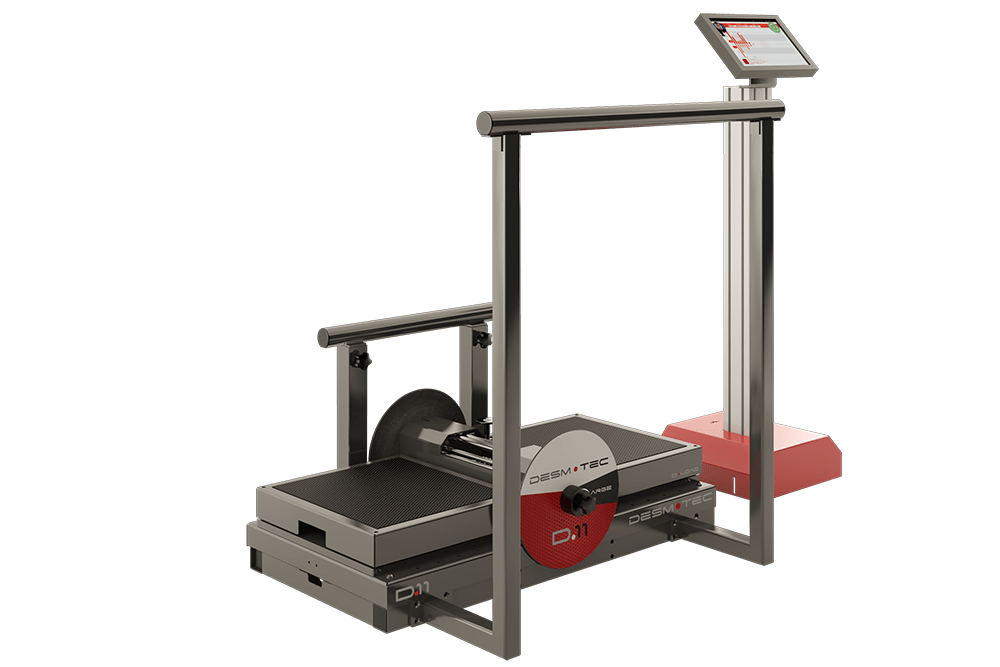Post-activation potentiation effect of eccentric overload and traditional weightlifting exercise on jumping and sprinting performance in male athletes
Scientific feature that evaluate the PAP effects on pre-determined exercises, following eccentric overload.
It was published by Prof. Marco Beato, Desmotec Academy Member and Senior Lecturer in Strength & Conditioning at University of Suffolk, on the Journal PLoS ONE, Semptember 2019.
The aim of this study was to evaluate the post-activation potentiation (PAP) effects following eccentric overload (EOL) and traditional weightlifting (TW) exercise on standing long jump (SLJ), countermovement jump (CMJ), and 5 m sprint acceleration performance. DESMOTEC DEVICE D.FULL was used during the research process.
Desmotec D.FULL
ABSTRACT
The aim of this study was to evaluate the post-activation potentiation (PAP) effects following eccentric overload (EOL) and traditional weightlifting (TW) exercise on standing long jump (SLJ), countermovement jump (CMJ), and 5 m sprint acceleration performance. Ten male athletes were involved in a randomized, crossover study. The subjects performed 3 sets of 6 repetitions of EOL or TW half squat exercise followed by SLJ, CMJ, and 5 m sprint tests at 1 min, 3 min and 7 min, in separate sessions using a randomized order. Bayes factor (BF10) was reported to show the strength of the evidence. Differences were found using EOL for SLJ distance at 3 min (BF10 = 7.24, +8%), and 7 min (BF10 = 19.5, +7%), for CMJ at 3 min (BF10 = 3.25, +9%), and 7 min (BF10 = 4.12, +10.5%). Differences were found using TW exercise for SLJ at 3 min (BF10 = 3.88, +9%), and 7 min (BF10 = 12.4, +9%), CMJ at 3 min (BF10 = 7.42, +9.5%), and 7 min (BF10 = 12.4, +12%). No meaningful differences were found between EOL and TW exercises for SLJ (BF10 = 0.33), CMJ (BF10 = 0.27), and 5 m sprint (BF10 = 0.22). In conclusion, EOL and TW exercises acutely increase SLJ and CMJ, but not 5 m sprint performance. The PAP time window was found between 3 min and 7 min using both protocols. This study did not find differences between EOL and TW exercises, and so both methodologies can be used to stimulate a PAP response.
Click here to read the whole feature.
Effects of postactivation potentiation after an eccentric overload bout on countermovement jump and lower-limb muscle strength.
Scientific feature that shows the results of Eccentric training evaluated through Specific tests.
It was published by Prof. Marco Beato, Desmotec Academy Member and Senior Lecturer in Strength & Conditioning at University of Suffolk, on the Journal of Strength and Conditioning Research, January 2019.
The aim of this project is to evaluate the postactivation potentiation (PAP) effects of an eccentric overload (EOL) exercise on countermovement jump (CMJ) performance and isokinetic lower-limb muscle strength. The Desmotec device D.Full was also used in the research process.
Desmotec D.FULL
ABSTRACT
Beato, M, Stiff, A, and Coratella, G. Effects of postactivation potentiation after an eccentric overload bout on countermove- ment jump and lower-limb muscle strength. J Strength Cond Res XX(X): 000–000, 2018—This study aimed to evaluate the postactivation potentiation (PAP) effects of an eccentric over- load (EOL) exercise on countermovement jump (CMJ) perfor- mance and isokinetic lower-limb muscle strength.
Eighteen active men (mean 6 SD, age 20.2 6 1.4 years, body mass 71.6 6 8 kg, and height 178 6 7 cm) were involved in a randomized, crossover study. The participants performed 3 sets per 6 repetitions of EOL half squats at maximal power using a flywheel ergometer. Postactivation potentiation using an EOL exercise was compared with a control condition (10-minute cycling at 1 W$kg21). Countermovement jump height, peak power, impulse, and force were recorded at 15 seconds, 1, 3, 5, 7, and 9 minutes after an EOL exercise or control. Furthermore, quadriceps and hamstrings isokinetic strength were performed.
Postactivation potentiation vs. control reported a meaningful difference for CMJ height after 3 minutes (effect size [ES] = 0.68, p = 0.002), 5 minutes (ES = 0.58, p = 0.008), 7 minutes (ES = 0.57, p = 0.022), and 9 minutes (ES = 0.61, p = 0.002), peak power after 1 minute (ES = 0.22, p = 0.040), 3 minutes (ES = 0.44, p = 0.009), 5 minutes (ES = 0.40, p = 0.002), 7 minutes (ES = 0.29, p = 0.011), and 9 minutes (ES = 0.30, p = 0.008), as well as quadriceps concentric, hamstrings concentric, and hamstrings eccentric peak torque (ES = 0.13, p = 0.001, ES = 0.24, p = 0.003, and ES = 0.22, p = 003, respectively) after 3–9 minutes of rest.
In conclusion, the present outcomes highlight that PAP using an EOL bout improves height, peak power, impulse, and peak force during CMJ, as well as quadriceps and hamstrings
isokinetic strength in male athletes. Moreover, the optimal time window for the PAP was found from 3 to 9 minutes.
Click here to read the whole feature.


